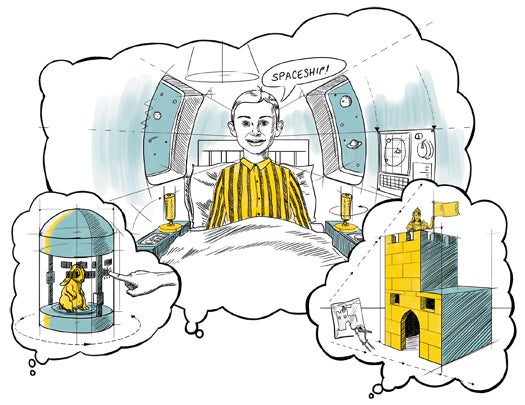What would the creators of some of the most beloved and widespread American toys make, if given a completely blank slate? We asked the driving forces behind toys like K’Nex, LEGO, Tickle Me Elmo, and Nerf to really explore their craziest impulses–and man, did they come up with some craziness.
Click to launch the Ultimate Toy gallery.
Print-a-Pet
“The personal pet creator would be the size of a mini-fridge and have a touchscreen interface. You would choose a robotic platform from a menu and then start adding features: How many legs? Is it aquatic? Amphibious? Avian? What length of fur or color of scales? You could also choose from a library of existing or mythical creatures. Next, the personality: language, likes and dislikes, etcetera. Then you press the big ‘make’ button and watch through the window as your personal pet is created.” –Caleb Chung, inventor of Pleo and co-inventor of Furby
Projecting Fantasy
“Imagine a toy that takes augmented reality to a new level, bringing a child’s imagination into the physical world. It combines voice recognition and location awareness with sound, image and smell projection. Say ‘spaceship,’ and the very walls of your room become the walls of your vessel, your bed the captain’s chair. Walk down the hall to your sister’s room, and you pass through the airlock and enter a Jovian landscape. Say ‘I’ve got a bad feeling about this,’ and sure enough, stinky little green men come streaming out of the closet. Will you fight them with your finger-laser or try to communicate? The real world becomes your magical adventure.” –Joshua Garrett, Contributor to Battleship LIVE, Monopoly LIVE and Sing-a-ma-jigs
2-D to 3-D
“I would love to have a transformation machine. You could take a snapshot of anything or even draw it, put the picture into the machine, and out would pop a three-dimensional toy version of the depicted object. If the original has working parts, like a bicycle, the 3-D toy would have the same working parts. And of course you could scale the toy version to any size you wanted—tiny, gigantic and anything in between.” –Michael Araten, CEO of K’nex
Living Blocks
“I propose LEGO bricks that reflect the fluid and evolving state of imagination—bricks that contain an organic quality such that, when assembled, they move from their static form to an organic creation. Builders immediately see feedback from the living creations they assemble based on the environment: light, force, sound and temperature. When you take them apart, the blocks return to their static parts.” –Søoren Holm, Senior director of the LEGO Concept Lab in Billund, Denmark
Liquid Fireworks
“I want a bubble solution that blows light-up bubbles that flash brilliant colors and stay floating at eye level for hours. You could pop them only with a special magic wand that makes them burst into a sparkling fireworks-like light show of glowing particles whose embers slowly fade away.” –Ron Dubren, Co-inventor of Tickle Me Elmo
Drivable Dinosaur
“I’d build a full-size Tyrannosaurus rex robot that a person can ride in. I’ve spent hours studying the T. rex skeleton at the Museum of Natural History in New York, and the proportions of the skull appear just about perfect for a reclined seat. The machine would be able to run and jump, not just shuffle like current robots. It would be powered by a turbine engine driving high-speed hydraulics. Control would rely on the balance and reflexes of the pilot rather than automatic stabilization.” –Robert Victor, Contributor to the Nerf Vortex






